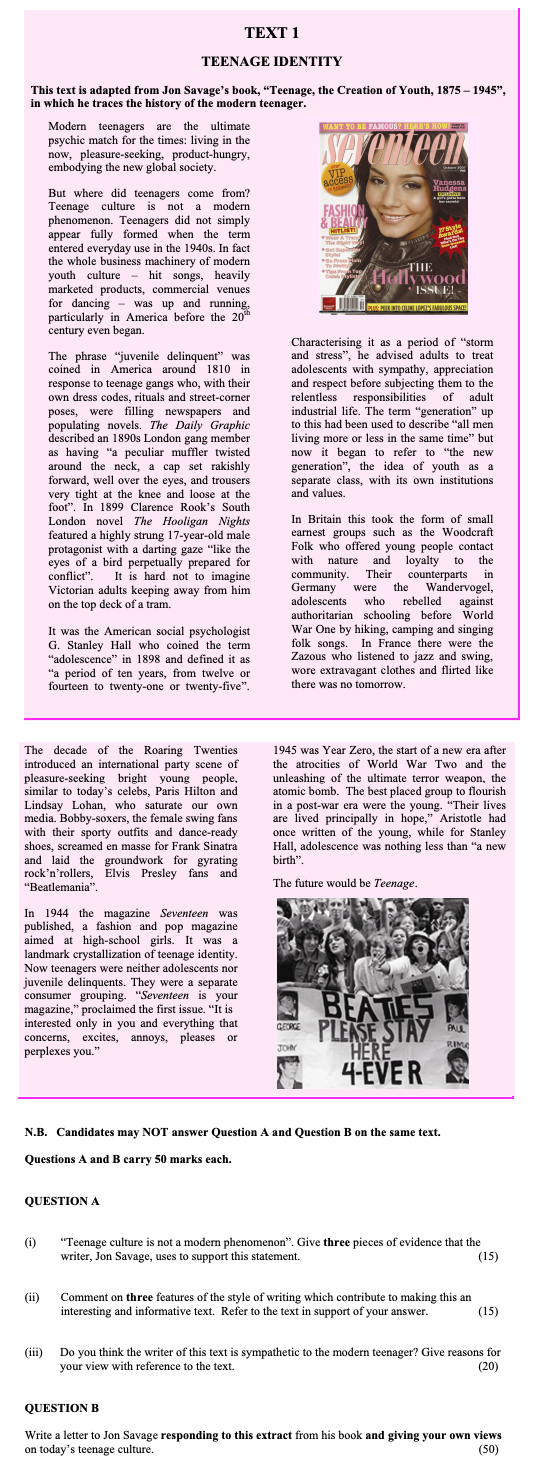Photo AI
“Teenage culture is not a modern phenomenon” - Leaving Cert English - Question QUESTION A - 2008
Question QUESTION A

“Teenage culture is not a modern phenomenon”. Give three pieces of evidence that the writer, Jon Savage, uses to support this statement. (15)
Worked Solution & Example Answer:“Teenage culture is not a modern phenomenon” - Leaving Cert English - Question QUESTION A - 2008
Step 1
“Teenage culture is not a modern phenomenon”. Give three pieces of evidence that the writer, Jon Savage, uses to support this statement.
Answer
-
Historical Origin of ‘Juvenile Delinquent’: The term "juvenile delinquent" was first introduced around 1810, indicating that the perception of teenagers as a distinct social group predates modern society. This shows that concerns about youth behavior have long historical roots.
-
Definition of Adolescence: G. Stanley Hall defined "adolescence" in 1898 as a significant developmental period, showing that society has recognized the unique experiences of teenagers for over a century. This historical perspective challenges the notion that teenage identity is a new phenomenon.
-
Teen Culture in the Roaring Twenties: The text discusses how the Roaring Twenties marked a distinctive period for youth culture, with references to the emergence of icons like Elvis Presley and the rise of new musical genres like rock and roll. This illustrates that the ideas and behaviors associated with teenagers have evolved but are not entirely modern.
Step 2
Comment on three features of the style of writing that contribute to making this an interesting and informative text. Refer to the text in support of your answer.
Answer
-
Engaging Definitions: The writer employs informative and interesting definitions, such as defining adolescence and explaining historical terms like 'juvenile delinquent'. This helps the reader grasp complex concepts easily.
-
Vivid Descriptive Details: The use of lively examples, like mentioning the various music and fashion trends of the Roaring Twenties, adds color to the narrative and allows readers to visualize the era's teenage culture.
-
Logical Structure: The text is organized coherently, presenting historical context first before diving into specific instances of teenage culture. This logical progression enhances its informative nature and keeps the reader engaged.
Step 3
Do you think the writer of this text is sympathetic to the modern teenager? Give reasons for your view with reference to the text.
Answer
In considering whether the writer is sympathetic to the modern teenager, it appears that he adopts an ambivalent stance. While he acknowledges the challenges of adolescence, referring to it as a time of "storm and stress", he also recognizes the potential for hope and possibility inherent in youth.
The writer's references to historical comparisons suggest a degree of respect for teenagers' ongoing struggles and triumphs. Moreover, by highlighting the rebellious nature of youth in the past, he seems to empathize with their continuous fight for identity in a changing world. This nuanced understanding indicates that while he may critique certain behaviors, he ultimately respects the complexity of modern teenage experiences.
